The AMD Llano Notebook Review: Competing in the Mobile Market
by Jarred Walton & Anand Lal Shimpi on June 14, 2011 12:01 AM ESTPower Gating
With 1.45 billion transistors on die, Llano relies on extensive power gating in order to keep things in order. The APU is split into two independent power islands: the CPU and the GPU. The memory controller and North Bridge both live on the GPU's power island. Each island has its own independent voltage source.
Everything from an individual CPU core to the entire GPU or virtually the entire APU package can be power gated. AMD provided photon recombination images to show the impact power gating the GPU can have on leakage current:
Although not depicted above, Llano can also fully power gate the x86 CPU cores or both the CPU and GPU if the entire APU is in a deep sleep state. Being able to completely power gate CPU cores or the GPU is an important part of enabling the next major feature of Llano: Turbo Core.
Turbo Core
All processors whether CPUs, GPUs or APUs have to be designed to strict thermal and power limits. OEMs need to know exactly what sort of chassis they'll be able to build around these chips and as a result the chip vendors provide guidance in the form of specifications, including the chip's thermal design point (TDP).
In the old days of microprocessors things were simple. You had a single core that ran all the time and it consumed all of the available thermal budget allocated for that core. AMD and Intel eventually enabled dynamic clock frequencies which let your single core underclock itself when it wasn't being used, which helped reduce power and extend battery life. Then came the multi-core era.
CPUs couldn't just start putting out twice as much heat now that they had two cores; instead, each core had to consume less power. The chip guys achieved this by running the cores at lower frequencies and voltages than they did in the single-core days. Two cores paved the way to four cores, which meant another reduction in clock speed per core. Sure we got much better multi-threaded performance, but for single-threaded applications performance wasn't as great as it could be. Users had to make a tradeoff: good multi-threaded performance or good single-threaded performance; you couldn't have both. Until power gating came along that is.
Without power gating you can never really shut off power to an idle core. The transistors aren't switching but power is still dissipated thanks to leakage current. Remember that transistors don't simply stop conducting electricity when they're off. The smaller they get, the more leaky our beloved transistors become. Power gating lets you physically block the flow of current to the transistors that are being gated, so when they're off, they're actually off. With an idle core shut off, now you have the extra TDP headroom to run any active cores at higher frequencies.
Intel does this with a technology it calls Turbo Boost. Intel looks at current draw and thermal sensors spread out all over the chip and determines when it has the available thermal headroom to turbo up any active cores. AMD implements a similar technology in Llano (and previously in their hex-core desktop parts) called Turbo Core.
I say similar but not identical because AMD's approach differs in a very important way. While Intel looks at current draw and temperature data, AMD looks at workload. Each activity within the Llano APU is assigned a certain power weight (e.g. an integer multiply is known to require a certain amount of power). Llano is aware of the operations it's currently working on and based on the weights associated with these operations it comes up with a general estimate of its power consumption on a per core basis. I mention this is an estimate because it correlates digital activity to power consumption; it doesn't actually measure power consumption.
Based on the number of events and their individual weights, AMD estimates the power consumption of each core and determines how much TDP headroom exists in the system. If the OS is requesting the highest p-state from the CPU and there's available TDP headroom, Llano will turbo up any active cores up to a maximum frequency. Like Sandy Bridge, Llano is able to temporarily exceed the APU's maximum TDP if it determines that the recent history of power consumption has been low enough that it'll take a while for the APU to ramp up to any thermal limits.
One major limit of Llano's Turbo Core is that the GPU can't turbo up in the event of the CPU cores being idle. Only the CPU cores can turbo up if they have available headroom. I suspect future versions of Llano will probably enable GPU Turbo Core as well:
It's unclear to me at this point what shortcomings or advantages exist for AMD's Turbo Core method vs. Intel's Turbo Boost. At the bare minimum the two are finally comparable although they use different approaches to attain a similar end result. AMD doesn't yet have a method of actually displaying Turbo Core frequencies, unfortunately, so we're operating a bit blind at this point. Over time I hope to have a better idea of how AMD's solution stacks up.


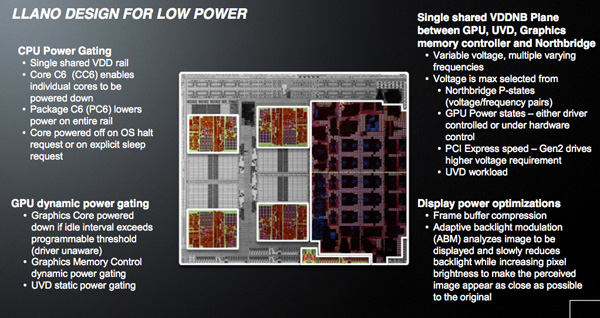
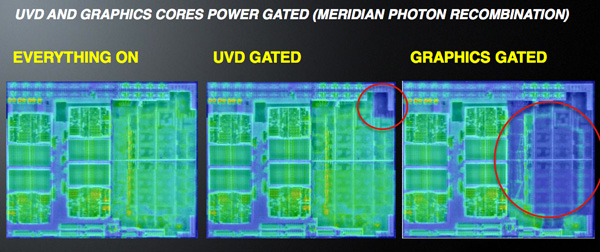
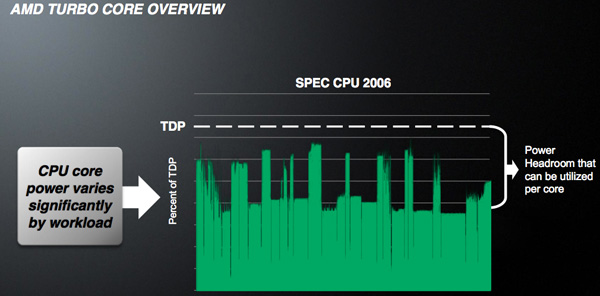
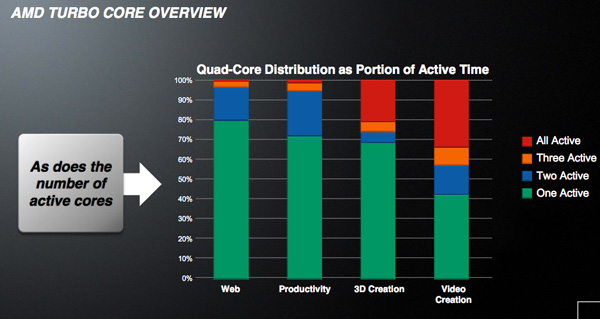
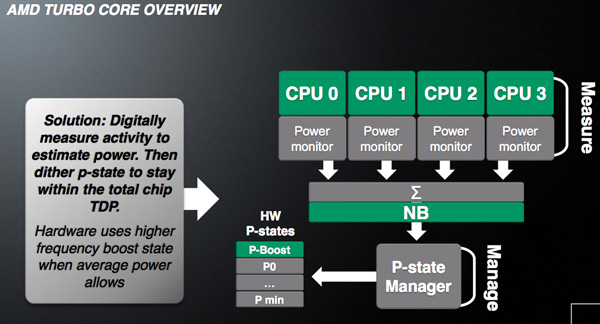
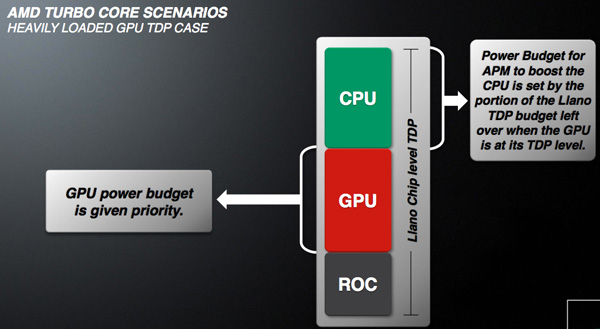
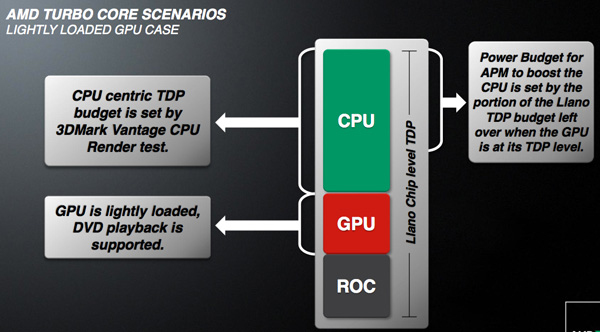








177 Comments
View All Comments
ET - Tuesday, June 14, 2011 - link
Legit Reviews found a big difference in game performance between AC and battery (see here: http://www.legitreviews.com/article/1636/5/). This made Llano and the i5 perform about the same on battery in Resident Evil 5. I assume that benchmarks here are on AC, so it would be interesting to test on battery.DXM1 - Tuesday, June 14, 2011 - link
Great Review Anand! Once again we know intel is the best at all things computing. I liked how you included the i7 with 460m up to THREE times in some benchmarks. It was like you kept reminding us and casual consumers that massively more expensive parts perform better... Even if you test the same set-up 3 times in a row!I have to tell you that seeing the 3 intel blue bars on the top made me sigh with relief, I was worried that you may actually compare llano to the parts like i3 and i5 where it is actually meant to compete (like some other silly reviewers). My only gripe is you didnt add i7-2600kand gtx 580 OC'ed as those would have made the gap even wider from the AMD system.
One question I did have for you is, how much does Intel pay nowadays for dishonest reviewing practices? Im short on cash because my job doesnt pay well and I was hoping to open up a website and promote intel just like you. Maybe we could even become partners and link to each other websites I think that would be cool.
PS, could you post how much your integrity was worth before you auctioned it off to Intel? Im sure some of your fans would be eager to know.
Your ex Reader, DXM1
Sharken03 - Tuesday, June 14, 2011 - link
Dont feed this troll, Anandtech is a great hardware site.Jamahl - Tuesday, June 14, 2011 - link
Troll? it's the truth. What was the fucking point in showing 3x identical intel systems except to put 3x intel systems at the top of most benchmarks? It's goddam pathetic.JarredWalton - Tuesday, June 14, 2011 - link
Or, I included these laptops because they're the only ones I still had where I could rerun all the benchmarks (specifically, PCMark 7 and 3DMark 11). Oh, snap! Heaven forbid we think about that. And if you read the 8000+ words of commentary, you'll notice how often we praise Intel's placement at the top of the charts -- and of course we completely ignore when they fall to the bottom of the battery life charts.I wish I had a secret stash of all the laptops I've tested in the last six months, because then I wouldn't have even bothered with including more than one GTX 460M + SNB. But your suggestion that we *not* include laptops because it pushes Llano down is even worse than what we've done. Should we only show laptops where AMD is better? Or maybe just laptops that cost under $700? Maybe we need to dig out an old CULV setup and then benchmark GMA 4500MHD again so we can laugh at Intel's IGP from two years ago?
If you want a look at every laptop we've tested and where Llano falls in the grand scheme of things, I suggest checking into our Mobile Bench results. Hint: it's in the upper part of battery life, and in the middle to lower part of CPU and GPU tests; if you only look at IGPs, though, it's the fastest IGP. Hmm... that sounds a lot like what we said in our conclusion.
pfastovsky - Tuesday, June 14, 2011 - link
JarredI think its a fair comment that asks Anandtech to keep their graphs in an article consistent with the same laptop set across a testing segment. As you said, you had to rerun all the benchmarks so why are the Civ laptops listed so different from Mass Effect, Starcraft etc?
Thanks
ET - Tuesday, June 14, 2011 - link
The comment may be fair, and it's been mentioned before, but accusing Anandtech of being paid by Intel isn't.krumme - Tuesday, June 14, 2011 - link
None of this explains the 3 identical setup.How on earth to you think it looks like?
Its simply utterly pathetic, and an insult at our IQ
I am no fan at this Llano apu, and from the start. think AMD should just have posponed it, and used the capacity for BD and serverspace, but this review is just far out.
The important issue about llano have always been the power profile, and AMD just deliver in spades here. Far beyound expectations. The OEM will sell this like zakate, and the new trinity will not make it significantly better on the market than this with upgraded star cores.
JarredWalton - Tuesday, June 14, 2011 - link
You know what's utterly pathetic and an insult to people's IQ? The suggestion that they can't actually comprehend the graphs. But just to show you that I have no "agenda" and I'm not trying to make AMD's Llano look worse than it is, I have taken a couple hours to go through, remove all the extra data, and regenerate all the graphs. (Yes, folks, creating all of these things does take time and our UI for doing this is not as easy as you might expect.) Of course, not all of the i7-2630QM + GTX 460M notebooks performed equally, so now I've "punished" Intel by showing worse results in some tests. Oh noes!Anyway, thanks for the input and sorry if the inclusion of more laptops was deemed offensive by some. They're just charts, people, and I even colored the "high-end" laptops bright blue so that you could easily filter them out in your mind. You know, something like: "Oh, those lines at the top are bright blue, so they're for quad-core Sandy Bridge laptops that cost about twice what the Llano laptop is expected to cost."
AnandThenMan - Tuesday, June 14, 2011 - link
Although I don't like the approach of the poster taking issue with the graphs, I completely agree on principle. This site has shown a clear pattern of making sure certain hardware always occupies the top of the graphs. Always. And don't insult our intelligence and pretend otherwise, please.Need I also remind people that this site included hand picked, overclocked Nvidia supplied cards (to the insistence of Nvidia) despite a policy that forbids this. I would caution people to take all results on this site with a grain of salt.